culturalrelics教学设计教案
人教课标版必修2 Unit 1 Cultural relics 阅读课教学设计
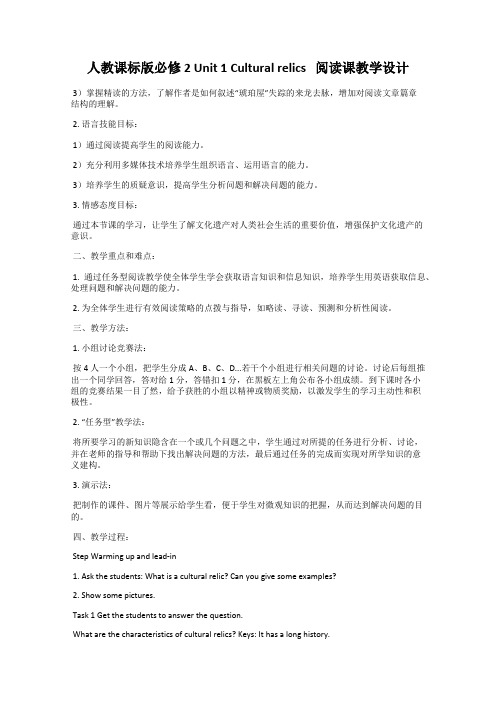
人教课标版必修2 Unit 1 Cultural relics 阅读课教学设计3)掌握精读的方法,了解作者是如何叙述“琥珀屋”失踪的来龙去脉,增加对阅读文章篇章结构的理解。
2. 语言技能目标:1)通过阅读提高学生的阅读能力。
2)充分利用多媒体技术培养学生组织语言、运用语言的能力。
3)培养学生的质疑意识,提高学生分析问题和解决问题的能力。
3. 情感态度目标:通过本节课的学习,让学生了解文化遗产对人类社会生活的重要价值,增强保护文化遗产的意识。
二、教学重点和难点:1. 通过任务型阅读教学使全体学生学会获取语言知识和信息知识,培养学生用英语获取信息、处理问题和解决问题的能力。
2. 为全体学生进行有效阅读策略的点拨与指导,如略读、寻读、预测和分析性阅读。
三、教学方法:1. 小组讨论竞赛法:按4 人一个小组,把学生分成A、B、C、D...若干个小组进行相关问题的讨论。
讨论后每组推出一个同学回答,答对给1 分,答错扣1 分,在黑板左上角公布各小组成绩。
到下课时各小组的竞赛结果一目了然,给予获胜的小组以精神或物质奖励,以激发学生的学习主动性和积极性。
2. “任务型”教学法:将所要学习的新知识隐含在一个或几个问题之中,学生通过对所提的任务进行分析、讨论,并在老师的指导和帮助下找出解决问题的方法,最后通过任务的完成而实现对所学知识的意义建构。
3. 演示法:把制作的课件、图片等展示给学生看,便于学生对微观知识的把握,从而达到解决问题的目的。
四、教学过程:Step Warming up and lead-in1. Ask the students: What is a cultural relic? Can you give some examples?2. Show some pictures.Task 1 Get the students to answer the question.What are the characteristics of cultural relics? Keys: It has a long history.It is beautiful, magnificent!A part of it has remained.It tells us about the past.It played an important role in the history.Many big events happened to it.It becomes the pride of the country....[设计说明]通过竞赛、观看有关图片及小组讨论等形式,激发学生的学习兴趣,训练学生说的能力,为下面的阅读作好铺垫。
culture relics 教案
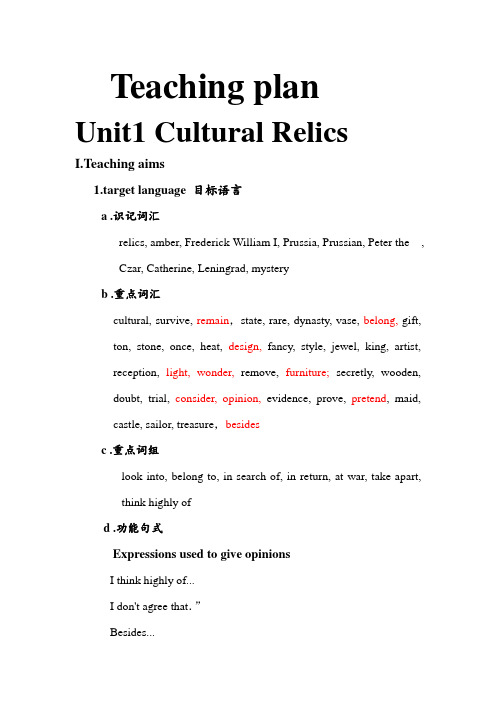
Teaching planUnit1 Cultural RelicsI.T eaching aims1.target language 目标语言a .识记词汇relics, amber, Frederick William I, Prussia, Prussian, Peter the ,Czar, Catherine, Leningrad, mysteryb .重点词汇cultural, survive, remain,state, rare, dynasty, vase, belong, gift,ton, stone, once, heat, design, fancy, style, jewel, king, artist,reception, light, wonder,remove, furniture;secretly, wooden,doubt, trial, consider,opinion,evidence, prove,pretend, maid,castle, sailor, treasure,besidesc .重点词组look into, belong to, in search of, in return, at war, take apart,think highly ofd .功能句式Expressions used to give opinionsI think highly of...I don't agree that.”Besides...I must say that I agree with you.I must say that I don't agree with you. As far as I'm concerned, I think...As I see it...Don't you agree /think (that)...I can't help thinking (that)...I would like to say...In my opinion/view... Personally, we should…Well, obviously we should…The point is...Asking for opinionsDo/Don‟t you think that…?Why/Why not …?How do you know that?What do you think?What‟s your idea/opin i on of…?How do you feel about…?What are your reasons for saying that? Would you consider…?Do you have any idea about…?Are you sure that he/she was telling the truth?What do you think of …?What would you say…?Who do you think was…?2. Ability goal 能力目标Enable the students to know the meaning of cultural relics and talk about some details of some famous cultural relics in English and express or support an opinion with suitable expressions.II. T eaching important pointsLet students learn to use the structures of expressing and supporting an opinion.III. T eaching difficult pointsKnow what restrictive attributive clause and non restrictive attributive clause areIV. T eaching aidsBlackboard, chalks, picturesV. T eaching procedures第一课时Step1 warming upShowing the pictures as followingsTelling them 3kinds of cultural relics just as the pictures show : ivory Mouth Buddha, cultural site of He Mudu, building clusters.Step2 Pre-readingRising questions as:1. Do you know what amber is?2. Have you ever seen a piece of amber?Then showing students the pictures making up of amber and give them 5miutes to taking about it.5minutes laterTell them that amber is a hard yellowish brown clear substance. it is often used for jewels and decorative objects.Step3 ReadingGive brief introduction of the persons of Frederick1, Frederick william1, Peter the Great, Catherine2, The Nazi army, The Russians and Germans before they start to read and also ask them to notice the time and the place the story happened , who made the Amber Room? why?When the Amber Room disappeared?What finally happened to the Amber Room?After reading, explain the whole passage in detailsStep4 ComprehendingGive students 8minutes to do the exercise in the comprehending then check the answers.Homework1. Let them talk about the some cultural relics the know best or the ones they want to know about and show their opinions nextclass,2. Let students do the exercises in the Learning about Languageand check it in the next class.第二课时Step5 Learning about LanguagePart1 Check the answer in the Learning about LanguageTell the students the meaning of the phrases and passage inthe exercise. Giving the correct answers and then analyzingthe whole passagePart2 Then asking students to read the meanings of the phrase “belong to”and do the relevant exercises. Then show thestudents the English meanings of the phrases such as“look into”, “in return”.Part3 Ask students to go back to the passage and to find out the attributive clauses and the non-attributive clauses.Then tell them how to distinguish attributive clauses andnon-restrictive clauses and give them some examples toexplain them. SRestrictive attributive clauses give important information to finda popular thing or person from two or more other things orpeople.Non-restrictive attributive clauses give extra information which is interesting or useful but not essential for finding a particular thing or person, there is usually a comma before the non-restrictive attributive clauses.Restrictive & non restrictive clausesDo the following pairs of sentences mean the same thing?1a My uncle, who lives in London, is very rich.2b My uncle who lives in London is very rich.2a The policies, which were unpopular, were rejected by the voters. 2b The policies which were unpopular were rejected by the voters. 3a My niece, whose husband is out of work, will inherit the house, which I have always treasured3b My niece whose husband is out of work will inherit the house which I have always treasured.The first sentence in each pair has a non-restrictive clause within two commas, and the second has a restrictive clause. Anon-restrictive clause simply adds more information into thesentence and does not affect the meaning of the main clause: itis therefore bracketed off with commas (1a = an uncle whohappens to live in London). Conversely, a restrictive clausedefines its referent in the main clause more specifically andcontributes significantly to the meaning of the sentence. Thus itis that particular uncle who lives in London who is referred to(1b). In 2a, all policies were unpopular and all were rejected,whereas in 2b only the policies that were unpopular were rejected.Note that in restrictive clauses the non-human relative pronoun iseither …that‟ or …which‟, whereas for human referents the relativepronoun can be either …who/m‟ or …that‟ (the man t hat/whom Iwill marry.第三课时Step7 Using LanguageReading and listeningPart1 Give them 4mins to read this passage, then ask them to tellme what a fact is and what an opinion is.Part2 Read the passage in the exercise2 and ask several studentsto answer the question. Do you think it is a fact or an opinion andgive reasons.Part3 Fill the table.Ask a student to check the answer.Part4 Pre-listeningRemind students of where and how the Amber Room havedisappeared, advise them to scan the table in the exercise3.Listen to Part A and Part B individually.Discuss in group of two and write down the message.Ask several Ss to report.Check.S peakingAsk students to do the express their opinions with theexpressions in the Speaking1 and give judgments of their usingof English and their oral English.Reading and writingPart1 ask students to read this letter and discuss the questions in the right list.Organize the students into two groups according theiranswers and let them to have a debate.Part2 Write a report using the following guidance ( hand in)Summing up1. Let them talk about the some cultural relics the know best or theones they want to know about and show their opinions nextclass,2. Write down what you have learned about culturalrelics______________________3. From this unit you have also learnedUseful verbs_______________________________Phrasal verbs______________VI Reflection:The lessons went well, but the students‟ too little knowledge about the cultural relics make them a little silence at class.。
Unit 1 Cultural relics教案

Unit 1 Cultural relics 一.Teaching contains1. Teaching objects: Class 6, Grade 12. Time: 8:00~8:45, Monday, 29th Nov. 2010.3. Teaching scope: 人教版英语必修二, UNIT 1, Cultural relics Warming up, Pre-reading, Reading and Comprehending from Page 5-6二.Teaching aims1. Knowledge goalsa. Enable students to learn the important words and phrasesrare, valuable, survive, vase, dynasty, amaze, select, honey, design, fancy, style, decorate, jewel, artist, belong to, troop, reception, remove, wooden, doubt, former, worth, in search of, in return, at war, less thanb. Enable students to learn the knowledge of cultural relicsc. Enable students to learn the history of the Amber Room2. Ability goalsa. Let students read the text to develop their fast reading skillsb. Enable students to talk about cultural relics3. Moral goalsa. Develop the students’sense of cultural relics’protection byreading this passageb. Develop the students’ sense of teamwork三.Teaching important points1. The definition of cultural relics2. Enable students to learn about the story of the Amber Room3. Enable students to learn the fast reading skills 四.Teaching difficult points1. Write a short passage about cultural relics2. Get the students to learn different fast reading skills and use them correctly五.Teaching methods1. Fast reading and intensive reading2. Team work3. Discussion六.Teaching aidsBlackboard, Chalks, Tape-recorder.七.Teaching procedures and waysStep 1 warming upGood morning, class. Let us begin our new lesson, unit 1, Cultural relics. Please turn to page five.1.Warming up by talking these picturesThere are four pictures on your textbook. They are all very famous objects and buildings in the world. Please think it over then answermy questions:A.Can you name them out?B.Where are they?(Keys for references: Ming Dynasty vase, China; Taj Madal, India; ivory dragon boat, China; Mogao Caves, China)2. Warming up by definingLet the students name out the famous things in the pictures and tell them they are cultural relics. Then explain what cultural relics are.A.Cultural relics are something that survived for a long time.B.Cultural relics may be a part of a country or a people’s culture.C.Cultural relics are something rather rare and valuable.While showing the explanation of cultural relics, teach the new words: survive, rare, and valuable.Step2 Pre-readingAs we know, all the cultural relics are quiet pretty, but some of them were lost and ruined, such as the Summer Palace in China and the Amber Room in Russia. Please guess:A.What kind of things can result in their disappearing?B.Why do they come into being again?C.Is it worth rebuilding lost cultural relics?Keys for references:A.Wars, natural disasters, and time have damaged and destroyedthem, getting them lost and changed. Many of them were even stolen and hidden while nobody knows who, where and how. B.People get to know those. If the relics could not be found again,it would be rebuilt by people.C.The cost; whether an object can be faithfully reproduced;whether it helps people better understand the reason why sucha building was destroyed.Step3 ReadingA. Skimming and scanning the general idea of each paragraphB. Listen to the tape recording of the text, please pay attention to each sentence and paragraph, and then working in groups, and discuss how to protect our cultural relics.Step4 ComprehendingNow, listen to the recording again, and do the Ex. 1 and 2.Ex.1: CEBDAFEx.2: 35412Step5 SummaryIn this lesson, we have learned how to read a passage fast and what cultural relics are. Fast reading skills are very useful in your daily life. You must take care of them.Step6 HomeworkCopy the new word and expressionsCopy the passage in the textbook。
Cultural relics教案
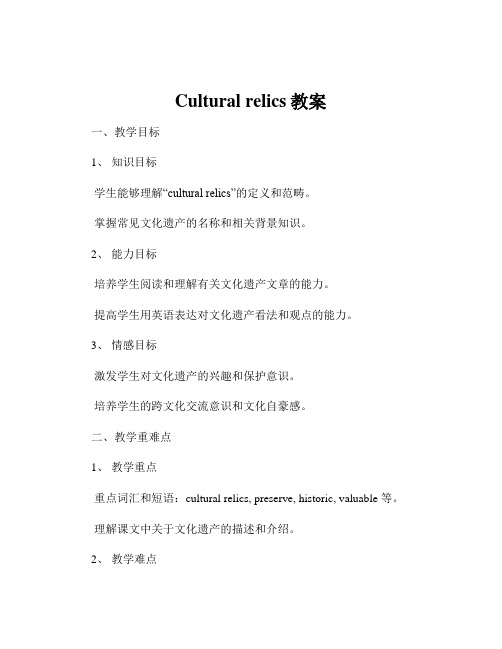
Cultural relics教案一、教学目标1、知识目标学生能够理解“cultural relics”的定义和范畴。
掌握常见文化遗产的名称和相关背景知识。
2、能力目标培养学生阅读和理解有关文化遗产文章的能力。
提高学生用英语表达对文化遗产看法和观点的能力。
3、情感目标激发学生对文化遗产的兴趣和保护意识。
培养学生的跨文化交流意识和文化自豪感。
二、教学重难点1、教学重点重点词汇和短语:cultural relics, preserve, historic, valuable 等。
理解课文中关于文化遗产的描述和介绍。
2、教学难点用英语准确表达对文化遗产保护的观点和建议。
引导学生深入思考文化遗产的价值和意义。
三、教学方法1、讲授法讲解重点词汇、语法和课文内容,使学生获得系统的知识。
2、讨论法组织学生对文化遗产相关话题进行讨论,培养思维和交流能力。
3、多媒体教学法通过图片、视频等多媒体资料,直观展示文化遗产,激发学生兴趣。
四、教学过程1、导入(5 分钟)展示一些著名文化遗产的图片,如长城、故宫等,提问学生是否知道这些是什么,引导学生进入文化遗产的主题。
2、词汇学习(10 分钟)呈现与文化遗产相关的新词汇,如“culturalrelics”“preserve”“historic”“valuable”等,通过讲解、举例和练习,帮助学生掌握这些词汇的用法。
3、阅读课文(15 分钟)让学生阅读一篇关于某种文化遗产的短文,理解其主要内容和细节。
提问学生关于短文的问题,检查理解程度。
4、小组讨论(15 分钟)分组讨论以下问题:“Why are cultural relics important?” “What canwe do to protect cultural relics?”每组选派代表进行发言,分享小组讨论的结果。
5、写作练习(15 分钟)要求学生根据讨论的内容,写一篇短文,阐述自己对文化遗产保护的看法和建议。
包艳红-Unit1-cultural-relics教学设计
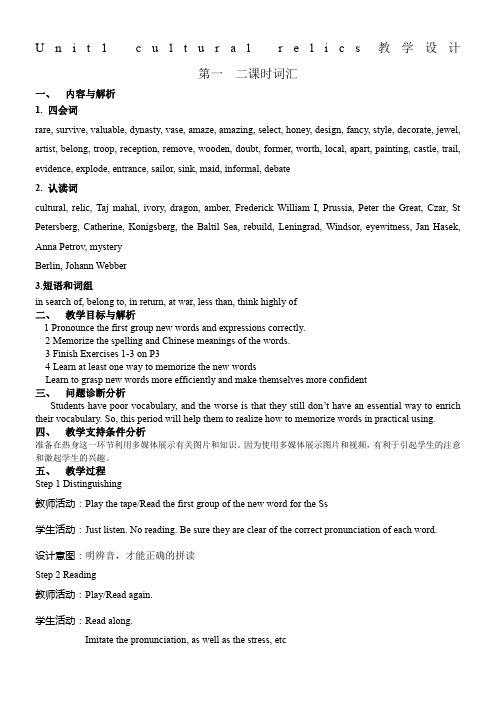
U n i t1c u l t u r a l r e l i c s教学设计第一二课时词汇一、内容与解析1. 四会词rare, survive, valuable, dynasty, vase, amaze, amazing, select, honey, design, fancy, style, decorate, jewel, artist, belong, troop, reception, remove, wooden, doubt, former, worth, local, apart, painting, castle, trail, evidence, explode, entrance, sailor, sink, maid, informal, debate2. 认读词cultural, relic, Taj mahal, ivory, dragon, amber, Frederick William I, Prussia, Peter the Great, Czar, St Petersberg, Catherine, Konigsberg, the Baltil Sea, rebuild, Leningrad, Windsor, eyewitness, Jan Hasek, Anna Petrov, mysteryBerlin, Johann Webber3.短语和词组in search of, belong to, in return, at war, less than, think highly of二、教学目标与解析1 Pronounce the first group new words and expressions correctly.2 Memorize the spelling and Chinese meanings of the words.3 Finish Exercises 1-3 on P34 Learn at least one way to memorize the new wordsLearn to grasp new words more efficiently and make themselves more confident三、问题诊断分析Students have poor vocabulary, and the worse is that they still don’t have an essential way to enrich their vocabulary. So, this period will help them to realize how to memorize words in practical using.四、教学支持条件分析准备在热身这一环节利用多媒体展示有关图片和知识。
CULTURAL RELICS教案1

教材分析i.教学内容分析本单元的话题是“文化遗产”。
reading部分主要介绍了有关俄罗斯遗失琥珀屋的轶闻。
learning about language 部分首先安排了根据英语释义搭配词汇的练习,力求巩固学生对新词汇的理解和记忆;此外,针对本单元的语法重点----定语从句,该部分还包含了相当分量的练习,让学生通过寻找课文中的定语从句启发学生去发现、归纳和复习限制性定语从句,同时引入非限制性定语从句的教学与训练。
learning tips 部分鼓励学生去参观博物馆或文化遗产胜地,学习有关的知识,尽力为外国游客提供导游服务,一方面可以借此机会锻炼自己的英语口语,另一方面也可以结交朋友。
ii.教学重点和难点1.教学重点(1) 本单元的生词和短语。
(2)掌握限制性与非限制性定语从句的用法,理解两者有何不同。
(3)了解琥珀屋的历史,了解世界文化遗产,增强文化遗产保护意识。
2.教学难点(1) 学会区别事实与观点,锻炼思维分析能力。
(2)用英语表达自己的看法或征求别人的看法。
iii.教学计划本单元分五课时:第三、四课时: learning about language第五课时: using languageiv.教学步骤:step 1 leading-insuggested dialogue:you: hello, i am here to see mr. zhang ri. are you zhang ri?man: yes, i am.man: oh, is there some problem?you: perhaps. i understand that you have an old ming dynasty vase.man: yes, i do but it's not mine. er-it belongs to my family.you: hmm. may i have a look at it?you: it's quite beautiful.man: i haven't heard about that.man: last year around the time of the mid-autumn festival.step 3. pre-readingstep 4. reading1st paragraph2nd paragraph3rd paragraph4th paragraph5th paragraphnumberthings about the number171617701941200360022100,00027300thnumberthings about the number1941the nazi german army stole the amber room.55the number of soldiers given to the king of russia in return1. get ss to finish ex1 (p2) and ex2 (p2).ex2:main idea of the passagegeneral idea of 1st paragraphgeneral idea of 2nd paragraphgeneral idea of 3rd paragraphgeneral idea of 4th paragraphgeneral idea of 5th paragraphmain idea of the passagethe history of the amber roomgeneral idea of 5th paragraphthe rebuilding of the amber room↙↘↘↙in 1941 the amber room stolen by the nazi german army para. 4↓step 6. language pointsi am pleased to have been of help to you. 我很高兴我对你有帮助。
必修2 unit1 cultural relics 教学设计
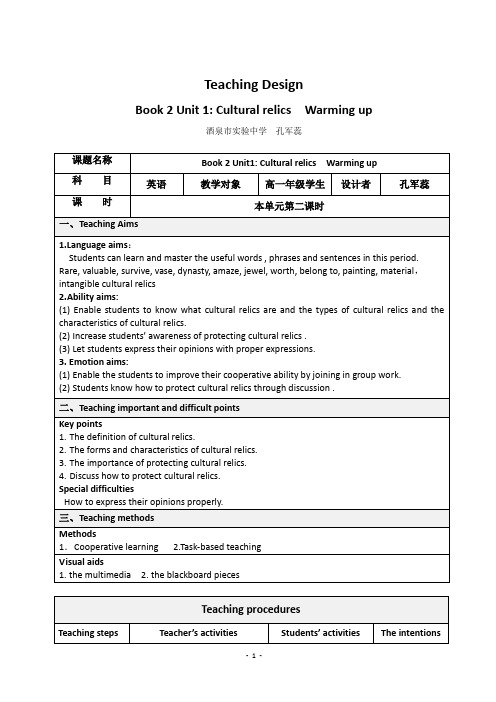
Teaching DesignBook 2 Unit 1: Cultural relics Warming up酒泉市实验中学孔军蕊板书设计教学反思通过课本和教材要求我首先整合教材进行了第一次备课。
确定这节课的教学目的为:1. 语言目标:学生们掌握以下单词短语的用法,为课堂上的表达作铺垫。
rare, valuable, survive, vase, dynasty,amaze, jewel, worth, belong to, painting, material,intangible cultural relics2. 能力目标:(1)了解文化遗产的概念、类型、特点和现状。
(2)能用简单的句型表达自己的观点。
(3)知道如何力所能及的保护我国的文化遗产。
3. 情感目标:(1)通过本节课了解文化遗产保护的重要性(2)通过小组合作,小组讨论的方式培养学生们的合作意识。
教学重难点为:1. 通过定义和观察了解文化遗产的类型和特点。
2. 文化遗产保护的重要性。
3. 小组讨论作为一个中学生该如何保护文化遗产。
教学方法为:任务型教学、合作学习其次,根据目标确定教学思路:本节课学生需要回答以下几个问题:1. 猜谜游戏“Guess what they are according to the tips.”。
2. 围绕已知的文化遗产的概念给出的问题“What other types can you think of ? ”。
3. 围绕概念展开的有关文化遗产的特点的问题“Brainstorm the characteristics(特点) of the cultural relics.”。
4. 有关情感升华的问题“Why do you think cultural relics are very important? ”。
5. 本节课的最终目的,讨论并得出答案“As students, what can we do to protect our cultural relics?”。
高中英语《CulturalRelics》教案设计
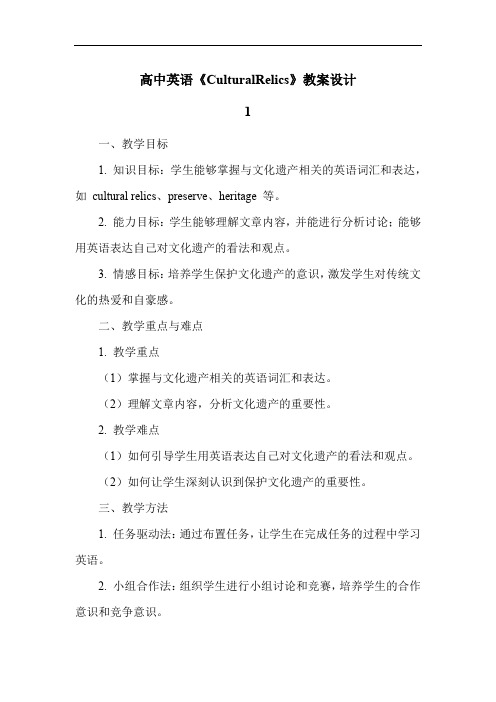
高中英语《CulturalRelics》教案设计1一、教学目标1. 知识目标:学生能够掌握与文化遗产相关的英语词汇和表达,如cultural relics、preserve、heritage 等。
2. 能力目标:学生能够理解文章内容,并能进行分析讨论;能够用英语表达自己对文化遗产的看法和观点。
3. 情感目标:培养学生保护文化遗产的意识,激发学生对传统文化的热爱和自豪感。
二、教学重点与难点1. 教学重点(1)掌握与文化遗产相关的英语词汇和表达。
(2)理解文章内容,分析文化遗产的重要性。
2. 教学难点(1)如何引导学生用英语表达自己对文化遗产的看法和观点。
(2)如何让学生深刻认识到保护文化遗产的重要性。
三、教学方法1. 任务驱动法:通过布置任务,让学生在完成任务的过程中学习英语。
2. 小组合作法:组织学生进行小组讨论和竞赛,培养学生的合作意识和竞争意识。
3. 案例分析法:通过分析实际案例,引导学生理解保护文化遗产的重要性。
四、教学过程1. 导入(5 分钟)(1)播放一段关于世界文化遗产的视频,如长城、金字塔等,让学生感受文化遗产的魅力。
(2)提问学生:“What are cultural relics? Can you name some cultural relics?”引导学生思考文化遗产的定义和例子。
2. 词汇学习(10 分钟)(1)展示一些与文化遗产相关的图片,如故宫、兵马俑等,让学生说出对应的英语词汇。
(2)讲解重点词汇和表达,如cultural relics、preserve、heritage 等,并让学生用这些词汇造句。
3. 课文朗读(10 分钟)(1)让学生先快速浏览课文,了解文章大意。
(2)播放课文录音,让学生跟读,注意语音语调。
(3)请几位学生朗读课文,其他学生认真听,并指出朗读中的错误。
4. 问题思考(15 分钟)(1)提出一些问题,让学生思考并回答。
例如:“What are the characteristics of cultural relics? Why should we preserve cultural relics?”(2)组织学生进行小组讨论,每个小组选出一名代表进行发言。
- 1、下载文档前请自行甄别文档内容的完整性,平台不提供额外的编辑、内容补充、找答案等附加服务。
- 2、"仅部分预览"的文档,不可在线预览部分如存在完整性等问题,可反馈申请退款(可完整预览的文档不适用该条件!)。
- 3、如文档侵犯您的权益,请联系客服反馈,我们会尽快为您处理(人工客服工作时间:9:00-18:30)。
Unit Unit 1 Cultural RelicsHeadingTopic and ContentTeaching Goals and Objectives Grade Level: Senior Grade OneTime: 45minDescription of students: For the students in grade1 in senior high school, their basic knowledge of cultural relics is enough. So the topic of this unit is familiar and easy to them. However, the passage in this unit is about another unfamiliar cultural relic---the Amber Room, so it is a little difficult to them. In addition, this passage is logically organized through three clues. So to the students, this passage is hard to grasp.Topic: Cultural RelicsTeaching Content:1.Key vocabulary: amazing, honey, decorate, select, belong, remove2.Subject matter:1.) recall the famous cultural relics around the world2.) emphasis the importance of protecting of cultural relics3.) reading comprehension---In Search of The Amber Room1.Teaching Goals:1.)Talk about history and background of the cultural relics2.)Improve the students’ reading ability through the passage2.Teaching Objectives:1). Ability objectivesTowards the end of this unit, the students should be able to:A. Enable the students to have the ability of talking cultural relics and ways to protect them.B. Learn some detailed information about the Amber Room.C. Train the students ability’ to grasp key information and clues while listening.D. Learn to skim for the main idea of this passageE. Fully understand the passage through the clues.F. Retell the passage in their own words.Teaching Key Points andDifficultPoints2). Emotion objectiveMake the students realize the importance of protecting the cultural relics and take action to protect them.1.Key Points:1).The key words and expressions;2). Learn some detailed information about the Amber Room;3). Train the students’abilityspeaking.4). Improve the students ’ reading ability, including skimming and scanning.2.Difficult Points:Train the students’ ability to grasp key information while listening.Lesson Step1Lead-in (4 minutes)outline Step2Speaking task( 3 minutes)Step3Pre-reading (4 minutes)Step4While-reading (22minutes)1). Fast reading (6minutes)2). Intensive reading (16minutes)Step5Post-reading(10minutes)Step6After-class assignment (2 minutes)Teaching ProceduresStep 1 Lead-in(4minutes)Warm-up Questions(1minute):Can you give me some examples of cultural relics that you know at home and abroad?Warm-up Activity(3minutes):1. Show students some pictures about the cultural relics around the world.E.g. The Great Wall, The Mogao Grottoes, The Pyramids in Egypt, Triumphal Arch⋯While showing these pictures, T asks the students some questions, for example:1.)Do you know where it is located?2.) Do you know what its function is in ancient time?3.) When you see this cultural relic, which country would come to your mind?2.T: In a common sense, people might think that cultural relics should be the ancient buildingswe mentioned just now. Actually, cultural relics can be viewed as many other forms, do you knowother forms of cultural relics? What are they?Then show students some other forms of cultural relics at the screen.E.g. Ancient village, Handcrafts, Natural environment, Folk culture ⋯ 3.Group DiscussionDirections: Divide students into several groups (2 or 3 students in one group), ask them to findout the characteristics a cultural relic has as many as they can according to the examples T gavebefore.At the end of the discussion, ask each student to show his or her answer to the class, and showstudents the complete answer at the screen. If the students feel difficult, T can give them one ortwo examples like this:preciousrare valuableA long history Cultural relics mysteriousWorld famous symbols of their countries and culturesMan-madeStep 2: Speaking task(3minutes)Directions: Through this part, T will show Ss the cultural relics are near extinction and make Ssrealize the importance of protecting the cultural relics.Question:1.What can cause some cultural relics lost or ruined?2.How to protect our cultural relics?After 2 minutes’preparation, T asks some students to show their answers and explain why.Step 3: Pre-reading(4minutes)1.Show students the title of this passage first, and ask students to think about the questions theywant to know through reading the passage, they may want to know these questions(2minutes): What is the Amber Room?Why was it called the Amber Room?What was it made for?What happened to it?Why to search for it?⋯⋯2. Introduce what Amber is and background of this passage to Ss(2minutes).Step 4:While-reading(22minutes)1). Fast reading (6minutes)Direction: Improve Ss’ability of skimming and scanning while fast-reading, after their fast-reading, they must find out the answers in the passage.Let students read the passage quickly (4minutes), and find out the answer of these questions, thenT checks answer with students (2minutes).1.Why was it called the Amber Room?2.What was it made for?3.Why to search for it?4.Find out the characters, years and places (clues of this passage) mentioned in the passage.Characters: Frederick I, Frederick William I, Peter the Great, Catherine , NaziPlaces: Prussia, Russia, GermanyYears: 1716, 1770, 1941, 20032). Intensive reading(16minutes)Directions: Improve the students’reading ability and learn some detailed information about the Amber Room.1.Let the students read the passage carefully with these purposes(8minutes):1.) The relationship between the characters2.) What happened in these places?3.) What happened to the Amber Room in the four years?After intensive reading, make the Ss work in pairs and find out the answers, then find some studentsto report their answers to the class, meanwhile, T gives the correct answers through the screen(5minutes).2.Make students work in pairs and summarize the gist of each paragraph(3minutes)Step 5:Post-reading(10minutes)Direction: Let the students do more exercises related to this passage, such as number the sentences, retell the story and a debate on this passage, to reinforce the comprehension of the passage.1.Demonstrate Ss some sentences and make them work in pairs to rank the sentences incorrect order according to the clues of the passage (3minutes).2.Let the students remind the three clues again and retell the story in their own words, Ss have 2minutes to prepare for it, then T ask some students to make an presentation in the front ofclass (3minutes).3.Divide Ss into two groups, then have a debate on this question: Is it worth rebuilding the AmberRoom? T can list some useful expressions that may be used in the debate (4minutes).Step 6:After-class Assignment(2minutes)1.Remember the useful words and expressions.2.Try to retell the story about the Amber Room in your own words and write down as a smallcomposition.3.Ask students to write a composition about a place that they have ever been to. (Its history,background, scenery )Teaching Methods1.Task-based Teaching2.Student-centered method3.KWL theory----K:known, W:want, L:learned4.Individual, pair or group work1). Watch some pictures about the cultural relics. (individuals)2). Have a discussion. (group work)3). Write an article about the discussion. (individuals)Teaching AidsMultimedia, textbook, pictures, blackboard,chalkSelf-reflection1.The advantage of this class:Before the first reading, T asks students to think about the questions they want to know, andthen solve their questions through reading one by one, this can increase stude nts ’ interest about the passage and make the reading more effective. Through finding out the three clues of this passage, the students can clearly understand the passage, and it is also useful to their retelling of the story later.2.The disadvantage of this class:1.) The contents is too much for the students to grasp in one period. Especially, the warming up occupies too much time.2.) Although T asks the students to raise questions by themselves and answer them while reading,if T ask other students to answer the questions they put forward before, it will be better.3.) This class should be arranged into 2 periods. (45min/period)。
